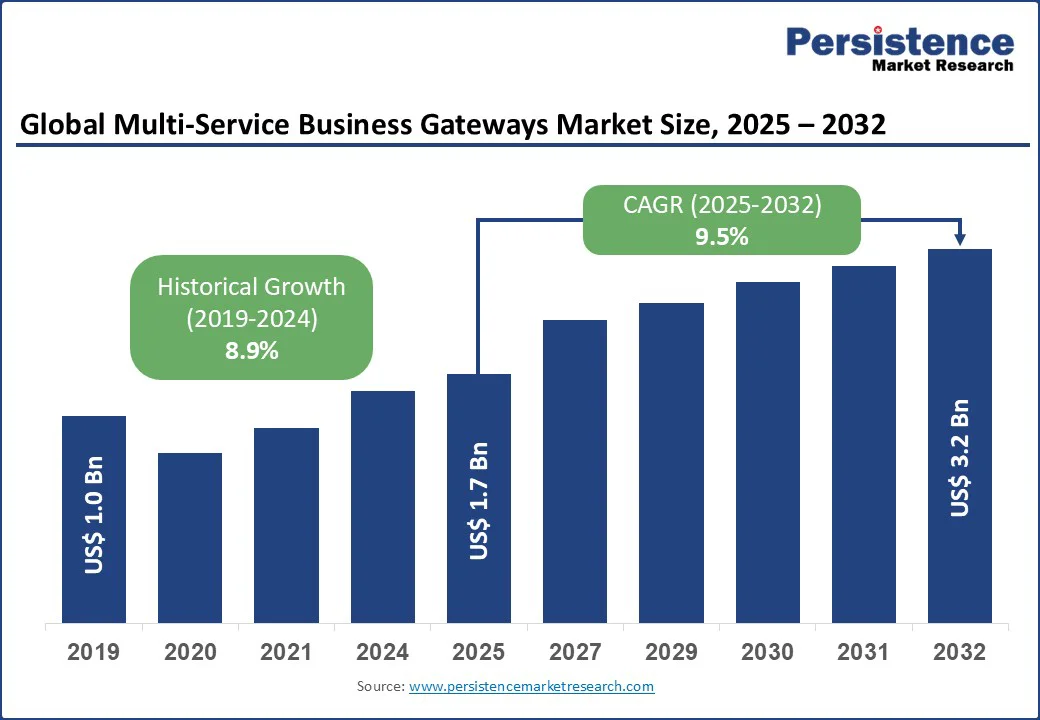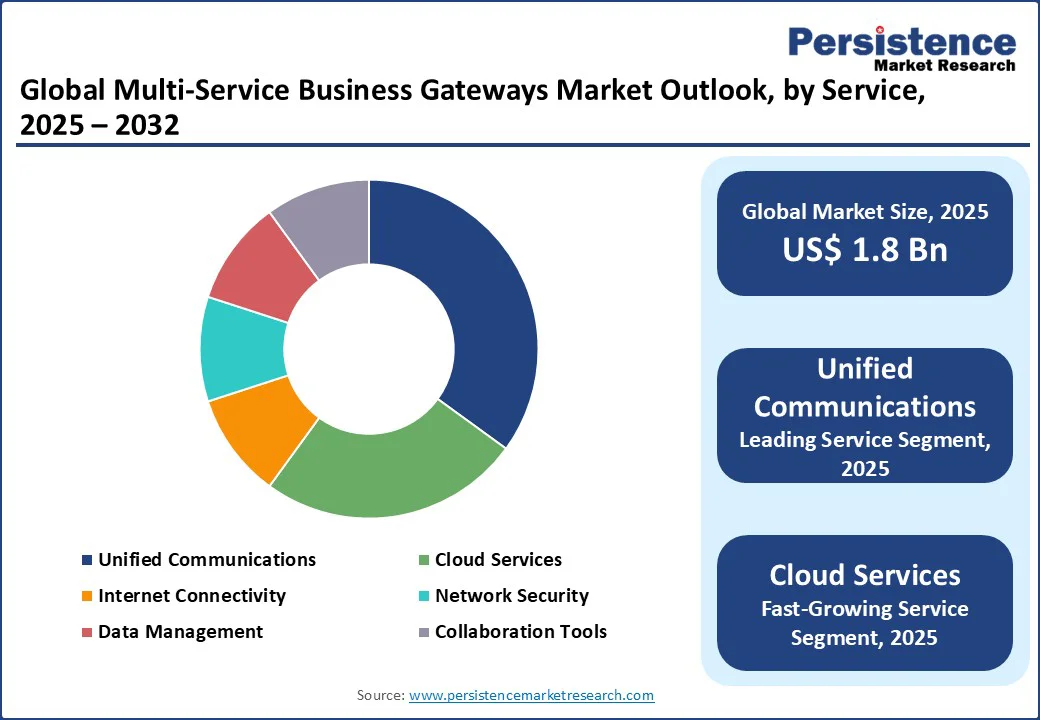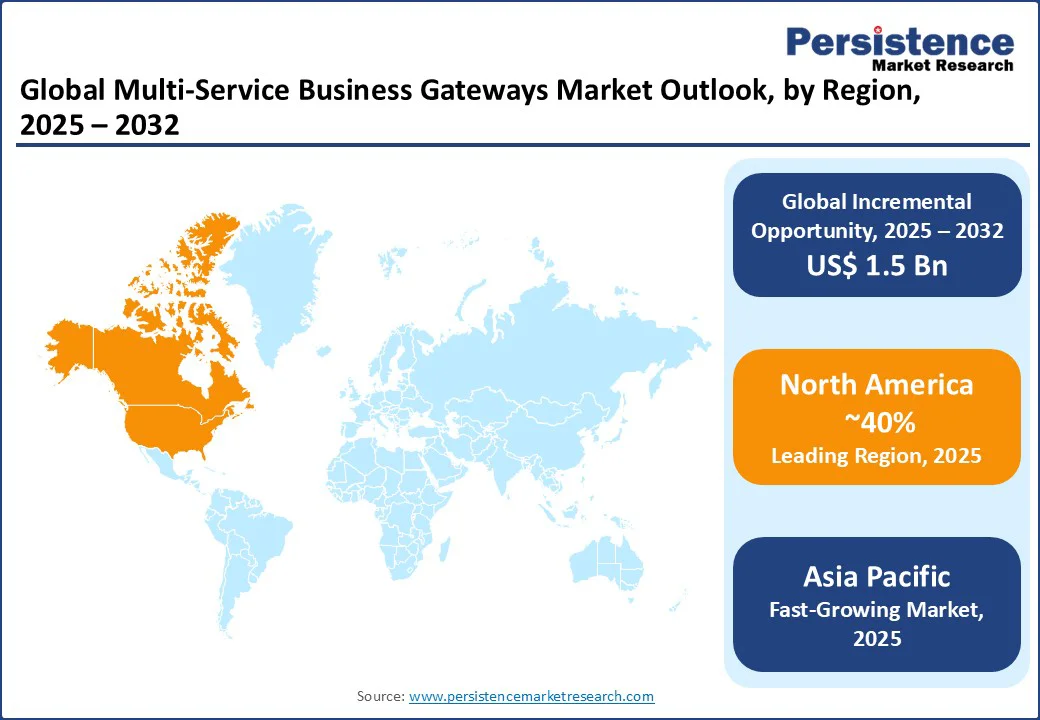ID: PMRREP5207| 196 Pages | 28 Aug 2025 | Format: PDF, Excel, PPT* | IT and Telecommunication

The global multi-service business gateways market size is likely to be valued at US$ 1.7 Bn in 2025, and forecasted at US$3.2 Bn by 2032, growing at CAGR of 9.5% during 2025-2032
The growth of the multi-service business gateway industry is driven by several factors, including the rising demand for unified communication solutions that consolidate voice data, routing, and security into a single platform, thereby reducing operational complexity and costs. Cloud integration and the shift toward software-defined, scalable deployments have significantly accelerated adoption, particularly among SMEs seeking cost-effective and flexible solutions.
Key Industry Highlights:

|
Global Market Attribute |
Key Insights |
|
Multi-Service Business Gateways Market Size (2025E) |
US$1.7 Bn |
|
Market Value Forecast (2032F) |
US$3.2 Bn |
|
Projected Growth (CAGR 2025 to 2032) |
9.5% |
|
Historical Market Growth (CAGR 2019 to 2024) |
8.9% |
The multi-service business gateways market is propelled by the accelerating demand for digital transformation and cloud-based gateway services, significantly boosting enterprise networking, multi-service gateways, and unified communication systems.
In 2025, 65% of enterprises globally adopted cloud-based solutions, driving demand for multi-protocol gateways for IP and voice services and next-generation business gateway solutions for ISPs. Cloud Services saw a 20% adoption increase in 2025 as businesses integrated unified communication multi-service gateway systems and SIP trunking gateways to streamline operations.
The telecommunications sector, with US$ 50 Bn in digital infrastructure investments in 2025, relies on VoIP gateways and network routers for data and voice service integration. Cisco Systems Inc. reported 15% revenue growth in 2025 from converged business gateways, driven by unified network infrastructure needs. The shift to remote work increased demand for broadband gateway devices by 25%, supporting managed network services.
The multi-service business gateways market faces a significant restraint due to the high initial investment and complexity of integrating multi-service gateways and unified communication systems. Deploying converged business gateways costs US$100,000 to US$500,000 per enterprise, posing a barrier for Small and Medium Enterprises (SMEs), with only 20% adoption.
The integration of multi-protocol gateways for IP and voice services requires 25% more IT expertise, resulting in increased implementation costs for network routers and VoIP gateways. In emerging markets, 30% of organizations cited compatibility issues with legacy systems as a barrier to the adoption of unified network infrastructure.
SIP trunking gateways and cloud-based gateway services require specialized maintenance, which adds 15% to operational costs. These challenges hinder the scalability of integrated service gateways and managed network services, particularly in cost-sensitive regions, impacting data and voice service integration and next-generation business gateway solutions for ISPs.
The multi-service business gateways market is poised for growth due to the increasing adoption of 5G and IoT technologies, creating opportunities for telecom gateways, broadband gateway devices, and unified communication multi-service gateway systems.
In 2025, 40% of global enterprises adopted 5G-enabled gateways, driving demand for multi-functional gateways and cloud-based gateway services. The IoT market, with 15 Bn connected devices, boosts data and voice service integration by 18%, supporting managed network services.
Next-generation business gateway solutions for ISPs benefit from 30% faster data transfer rates with 5G, enhancing unified network infrastructure. Huawei Technologies reported 12% growth in 5G-enabled converged business gateways.
Emerging markets such as India witnessed a 25% increase in IoT-driven enterprise networking, offering opportunities for SIP trunking gateways. These trends, supported by network security and collaboration tools, position the market for expansion in telecommunications, healthcare, and manufacturing.
Unified Communications are likely to account for a 35% market share in 2025, driven by unified communication systems and VoIP gateways. With 40% adoption in enterprises by 2025, it supports the integration of data and voice services, as well as SIP trunking gateways.
One of the key enablers is the use of SIP trunking gateways, which facilitate cost-efficient and scalable voice connectivity over IP networks, replacing traditional PSTN lines. The growth of this segment is further supported by the rising need for remote work solutions, video conferencing platforms, and real-time communication tools, all of which rely on unified communication infrastructure.
Cloud-based gateway services fuel Cloud Services. With 15% growth in 2025, it enhances the unified network infrastructure. Cloud-based gateways play a crucial role in delivering next-generation business gateway solutions for ISPs, enabling faster deployment, simplified management, and integration of advanced services such as VoIP, firewall, VPN, and SD-WAN through the cloud. This adoption is driven by subscription-based pricing models, minimal hardware requirements, and high availability, making cloud services highly attractive to enterprises of all sizes.
Large Enterprises Are Expected to command a 40% market share in 2025, driven by the adoption of converged business gateways. With 45% adoption in 2025 they rely on unified communication systems and network routers. This adoption is driven by the need for a high-performance, scalable, and secure networking infrastructure that supports diverse applications, including VoIP, video conferencing, cloud services, and data-intensive workloads. Large enterprises also prioritize network redundancy, zero-trust security, and software-defined WAN (SD-WAN) to enhance operational efficiency and business continuity.
SMEs fueled by multi-functional gateways. With 12% growth in 2025 SMEs adopt cloud-based gateway services for cost-effective enterprise networking. Cloud adoption also supports remote work, business continuity, and pay-as-you-go pricing models, making it an attractive choice for growing businesses. Additionally, the rising trend of digitalization among SMEs, the adoption of SaaS applications, and emphasis on cybersecurity further accelerate the adoption of these cost-effective gateway solutions.
Telecommunications are expected to hold a 30% market share in 2025, driven by telecom gateways. With 35% adoption in 2025, it supports next-generation business gateway solutions for ISPs. These gateways enhance VoIP integration, IP telephony, and network security, enabling telecom operators to reduce operational costs while improving service reliability. The trend toward 5G deployment, cloud-based communications, and software-defined networking (SDN) further accelerates growth in this segment, as service providers prioritize scalability and interoperability in their infrastructure.
Unified communication multi-service gateway systems fuel the transactions in healthcare domain. With 10% growth in 2025, it enhances the integration of data and voice services. These gateways facilitate secure data transmission, ensure HIPAA compliance, and promote interoperability with electronic health records (EHRs), thereby ensuring seamless information flow across departments. The surge in remote patient monitoring, IoMT (Internet of Medical Things), and AI-driven diagnostics further drives the demand for robust and unified communication infrastructure in healthcare facilities.
IT Management is projected to hold a 35% market share in 2025, driven by managed network services. With 40% adoption in 2025, it supports unified network infrastructure. The deployment of advanced network routers enhances scalability, security, and performance, enabling organizations to manage increasing data traffic effectively. This segment benefits from trends such as cloud integration, remote workforce support, and zero-trust security models, making it a critical component of modern IT strategies.
Operations Management fueled by multi-functional gateways. With 12% growth in 2025, it enhances the integration of data and voice services. These gateways support network automation, centralized monitoring, and real-time analytics, reducing downtime and operational costs. The growth is further supported by the need for robust infrastructure to handle IoT devices, edge computing, and high-bandwidth applications, positioning Operations Management as a vital enabler of digital transformation.

North America holds a 40% global market share in 2025, with the U.S. leading due to its advanced enterprise networking infrastructure and high adoption of digital solutions, generating US$0.68 Bn in sales in 2025. The U.S. market driven by unified communication systems, with 70% of enterprises adopting VoIP gateways in 2025. Key drivers include a 25% increase in cloud computing investments, reaching US$ 200 Bn in 2025, boosting cloud-based gateway services and SIP trunking gateways.
The rise of hybrid work models increased the demand for broadband gateway devices by 30%, supporting the integration of data and voice services. Cisco Systems Inc. holds a 20% regional share, leveraging multi-service gateway solutions for large enterprises, with 50% of Fortune 500 companies adopting converged business gateways.
The finance and banking sector, with US$10 Bn in cybersecurity investments, drives network security solutions. Additionally, telecommunications growth, with 15% adoption of next-generation business gateway solutions for ISPs, fuels unified network infrastructure, positioning the U.S. as a market leader.
Europe accounts for a 25% global share, led by Germany, the UK, and France, driven by robust digital infrastructure and regulatory support for enterprise networking. Germany’s market is propelled by telecom gateways, with 50% of enterprises adopting converged business gateways in 2025. The manufacturing sector, contributing €2 trillion to the economy, drives 20% growth in multi-protocol gateways for IP and voice services, supporting the integration of data and voice services.
U.K. market growth is driven by unified communication multi-service gateway systems, with 40% of SMEs adopting cloud-based gateway services. Government initiatives, with €500 Mn in digital transformation funding, boost managed network services.
France experiences 8% growth in the healthcare sector, with a 15% adoption rate of VoIP gateways for telemedicine, supported by Nokia Corporation’s integrated service gateways. EU regulations promoting 5G adoption have increased broadband gateway device deployment by 25%, thereby enhancing network security and facilitating unified network infrastructure.
Asia Pacific is the fastest-growing region, with a CAGR of 10.2%, led by China, Japan, and India, driven by rapid digitalization and 5G rollout. China holds a 45% regional share, fueled by US$15 billion in digital infrastructure investments, which boosts multi-protocol gateways for IP and voice services. The telecommunications sector, with 60% of ISPs adopting next-generation business gateway solutions for ISPs, drives 20% growth. India’s market is propelled by 25% growth in SMEs, with 30% adoption of cloud-based gateway services.
Government initiatives such as Digital India, with US$ 5 Bn in funding, enhance broadband gateway devices. Japan’s market experiences 12% growth in cloud-based gateway services, driven by a 15% adoption rate in healthcare for unified communication systems. Huawei Technologies expands with SIP trunking gateways, capturing 15% of the regional market. The region’s unified network infrastructure benefits from 40% 5G penetration, driving data and voice service integration.

The global multi-service business gateway market is characterized by the presence of several key players, each striving to gain a competitive edge through innovation and strategic partnerships. Companies are focusing on developing comprehensive and integrated MSBG solutions that cater to the diverse needs of enterprises across different industries.
The market is witnessing an increasing emphasis on research and development, with providers investing in the development of advanced technologies and features to enhance the capabilities of their MSBG systems. This focus on innovation is expected to play a crucial role in shaping the competitive dynamics of the market.
Collaboration and strategic partnerships are also becoming increasingly important in the MSBG market, as companies seek to expand their market presence and enhance their product offerings.
The multi-service business gateway market is projected to reach US$ 1.7 Bn in 2025, driven by multi-service gateway and unified communication systems.
Digital transformation and 65% enterprise cloud adoption in 2025 fuel demand for cloud-based gateway services and telecom gateways.
The multi-service business gateway market grows at a CAGR of 9.5% from 2025 to 2032, reaching US$ 3.2 Bn by 2032.
5G and IoT, with 40% enterprise adoption in 2025, offer opportunities for next-generation business gateway solutions for ISPs.
Key players include Cisco Systems Inc., Juniper Networks Inc., Nokia Corporation, Huawei Technologies Co. Ltd., and Fortinet Inc.
|
Report Attribute |
Details |
|
Historical Data/Actuals |
2019 - 2024 |
|
Forecast Period |
2025 - 2032 |
|
Market Analysis Units |
Value: US$ Bn, Volume: As Applicable |
|
Geographical Coverage |
|
|
Segmental Coverage |
|
|
Competitive Analysis |
|
|
Report Highlights |
|
|
Customization and Pricing |
Available upon request |
By Service
By Organization
By Vertical
By Functionality
By Region
Delivery Timelines
For more information on this report and its delivery timelines please get in touch with our sales team.
About Author